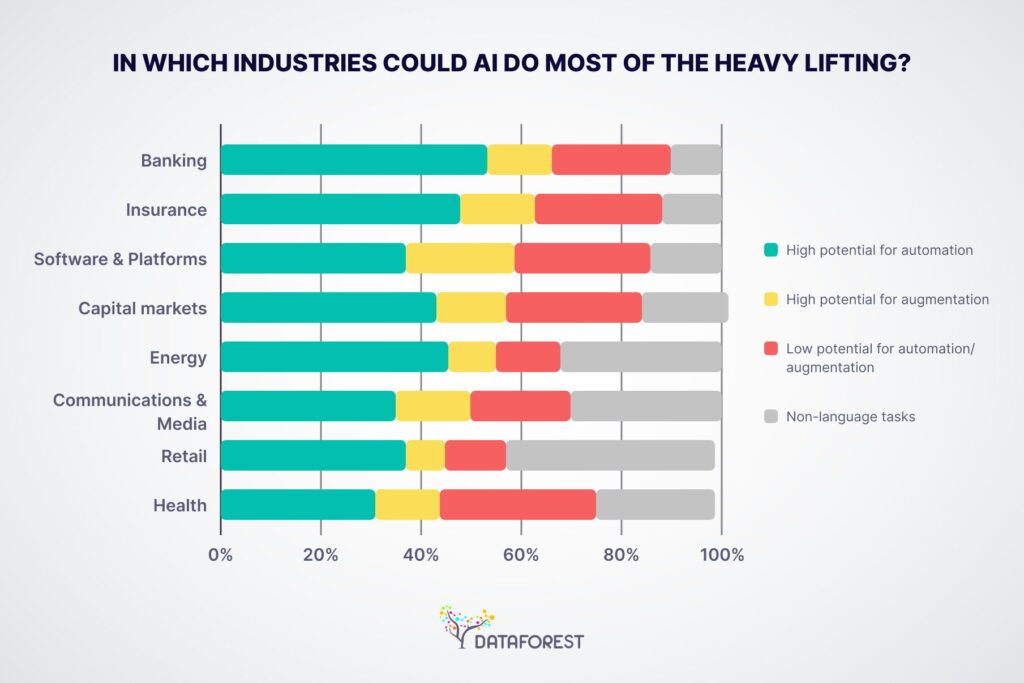Key drivers for AI adoption
Following our previous review on the “not-so-hidden” value of AI applications in Insurance industry, it’s time to revisit the basic drivers for AI adoption in business.
Businesses are leveraging GenAI to drive innovation and growth strategies, for its ability to transform key functions across operations, in order to enhance customer engagement via personalize offerings, and to gain a competitive edge by harnessing advanced data insights and automation capabilities. In fact, according to 2023 Gartner data, businesses prioritized GenAI for enhancing customer experience and retention (38%) and driving revenue growth (26%).
In addition, more recent studies provide an in-depth view on the business value of Generative AI in various industries.

Key milestones of AI applications in Insurance Industry
The adoption of AI in the insurance industry has followed a progressive timeline of innovation and impact, and leading carriers are integrating GenAI to reshape processes and boost operational efficiency, and finally, to unlock value across the insurance value chain.
In the early 2000s, insurers like GEICO and Progressive began exploring data-driven AI tools to improve risk modeling and pricing accuracy. These early efforts focused on leveraging structured datasets and basic AI algorithms to enhance underwriting decisions.
By 2010, telematics-based insurance emerged as a game changer, with companies such as Allstate and Progressive leading the way. They introduced usage-based insurance (UBI) programs, utilizing AI-powered telematics to monitor real-time driving behavior. This advancement enabled dynamic pricing models and incentivized safer driving practices, laying the groundwork for personalized insurance.
In 2015, insurers turned their attention to combating fraud, a significant drain on industry resources. Companies like AXA and Zurich Insurance adopted AI systems to detect fraudulent claims, using machine learning models to analyze patterns and anomalies. These innovations reduced financial losses and strengthened trust in insurance operations.
Between 2017 and 2020, AI-powered chatbots transformed customer service in insurance. Lemonade and Allianz implemented virtual assistants to automate tasks like policy inquiries and claims submissions. These 24/7 chatbots enhanced customer engagement by providing instant, reliable support while reducing operational costs.
The next leap came in 2022 with the integration of Generative AI. Companies such as State Farm, Nationwide, and MetLife embraced advanced AI models like ChatGPT to enhance processes across underwriting, claims automation, and marketing content creation. This marked a turning point for natural language understanding and improved client communication, streamlining operations throughout the insurance value chain.
Most recently, in 2023, predictive and preventative analytics took center stage. Insurers like Prudential and Swiss Re leveraged advanced AI models to assess risks tied to natural disasters and emerging health trends. These tools enabled a shift from reactive claims processing to proactive risk mitigation, offering cost savings and better preparedness.
AI in Insurance – what’s trending?
According to PwC’s 27th Annual Global CEO Survey, 70% of CEOs predict GenAI will significantly transform value creation and delivery, with 31% having already revised their technology strategies.
“Insurance leaders across Europe are continuing to invest in AI, as they seek to improve operational efficiency, increase productivity and enhance customer experiences through tech”
Phil Vermeulen, EY EMEIA Financial services Insurance Leader
- Sprout.ai reported that
- 59% of insurance organizations using GenAI acknowledge benefits like enhanced productivity (61%), improved customer service (48%), cost savings (56%), and growth acceleration (48%) ;
- top functional areas impacted: marketing (54%), claims (47%), underwriting (46%), and customer onboarding (43%).
- PwC’s 2024 GenAI Insurance Trends projects that in the insurance industry, nearly half of Generative AI’s value—measured as a percentage of operating profit uplift—comes from recurring use cases such as marketing content generation. This value is expected to grow as insurers deepen their understanding and focus on initiatives with higher transformational potential.
- According to EY, 69% of insurers favor targeted use cases that transform one area of the value chain. Future investments are expected to focus on predictive risk assessments and advanced underwriting capabilities.
- AI is valued to be worth $35.77 billion by 2030 within the insurance industry.
AI’s impact in the value chain of Insurance industry
Generative AI, while exemplified by tools like ChatGPT, represents a broad and transformative category of technology. Although ChatGPT is a significant innovation, it is just one component of Generative AI’s vast potential. The true power of Generative AI lies in its ability to revolutionize the insurance industry by processing and analyzing unstructured data – a crucial aspect of this knowledge-driven sector. By leveraging large language models (LLMs), GenAI can drive transformation across the insurance value chain, an area where its capabilities remain underutilized.
Insurers have an exceptional opportunity to unlock significant value by aligning GenAI investments with their strategic goals. These technologies enable companies to harness larger datasets to automate customer support, refine risk modeling, and enhance predictions. They also facilitate digitalization in areas like underwriting decisions, customer experience, and agent empowerment.
A Gartner analysis[1] highlights the extensive applications of GenAI in both Life and Property & Casualty (P&C) insurance. GenAI can impact every stage of the value chain, supporting:
- customer and consumer engagement;
- customer-facing employees and agent;
- operations and internal processes;
- product and service enhancement.
Claims Processing and Automation
Generative AI accelerates claims management by automating time-consuming processes. For instance:
- Medical Record Synthesis: AI extracts and summarizes key insights from patient records to expedite claims evaluations.
- Vehicle Damage Assessment: Advanced image recognition evaluates damage and generates repair estimates, drastically reducing settlement timelines.
- Predictive Analytics: These models forecast claims that may require manual review, optimizing resource allocation.
This automation enhances operational efficiency and strengthens customer trust by delivering faster, more accurate resolutions.
Fraud Detection
Insurers face significant financial losses due to fraudulent claims, and GenAI is pivotal in mitigating this risk:
- Anomaly Detection: AI flags suspicious patterns in data, such as inflated repair costs or repeated claims from the same individual.
- Dynamic Learning: Fraud detection systems continually adapt to evolving fraudulent tactics, staying ahead of emerging threats.
- Broader Data Utilization: AI integrates diverse datasets, including customer behavior and transaction history, to improve detection accuracy.
Our own experience in anti-fraud solutions
A leading company in the Greek Insurance market trusted us to implement a comprehensive anti-fraud solution aimed at the timely detection, supervision, and prevention of malicious activities or transactions
by Insurance Agents and Claimants.
Specifically, the client sought a solution to identify, investigate, and act in near real-time to avoid incidents such as premium avoidance, fictitious policies, coverage sliding (misunderstanding or misrepresenting terms and coverage), as well as cases of poor business practices, collusion, or fraud aimed at increased commissions or other benefits. To achieve this, ATC proposed the adoption of cutting-edge big data analytics tools combined with artificial intelligence models.
With the solution developed by ATC, the client will receive reliable and timely alerts for suspicious fraud cases in the property and casualty sector, enabling automatic detection and prevention of fraudulent activities while significantly reducing financial impacts.
Customer Experience Enhancement
AI-driven virtual assistants are transforming customer interactions:
- Guided Support: Virtual assistants handle inquiries about policies, claims status, and coverage options, offering instant, reliable service.
- Personalized Communication: By analyzing customer preferences, AI tailors responses and proactively addresses concerns, enhancing satisfaction.
Underwriting Optimization
Generative AI enables precise and tailored policy recommendations by analyzing complex data sets:
- Health and Lifestyle Analysis: AI assesses medical records, genetic information, and lifestyle habits to offer personalized health insurance plans.
- Driving Data Integration: Telematics data informs usage-based insurance (UBI) policies, rewarding low-risk drivers with discounts while ensuring fair pricing for high-risk behaviors.
- Dynamic Pricing Models: Predictive analytics allow for real-time policy adjustments, improving risk management and customer alignment.
Proactive Risk Management
AI applications go beyond reactive measures to focus on prevention:
- Natural Disaster Risk Prediction: By analyzing weather patterns and geographical data, insurers can proactively adjust coverage and premiums.
- Preventative Healthcare Strategies: Wellness programs, powered by AI insights, reduce healthcare costs by encouraging early interventions.
[1] “Quick Answer: What Role Does Generative AI Have in the Insurance Industry?”, by Kimberly Harris-Ferrante, Richard Natale (June 2023 – ID G00794693)





